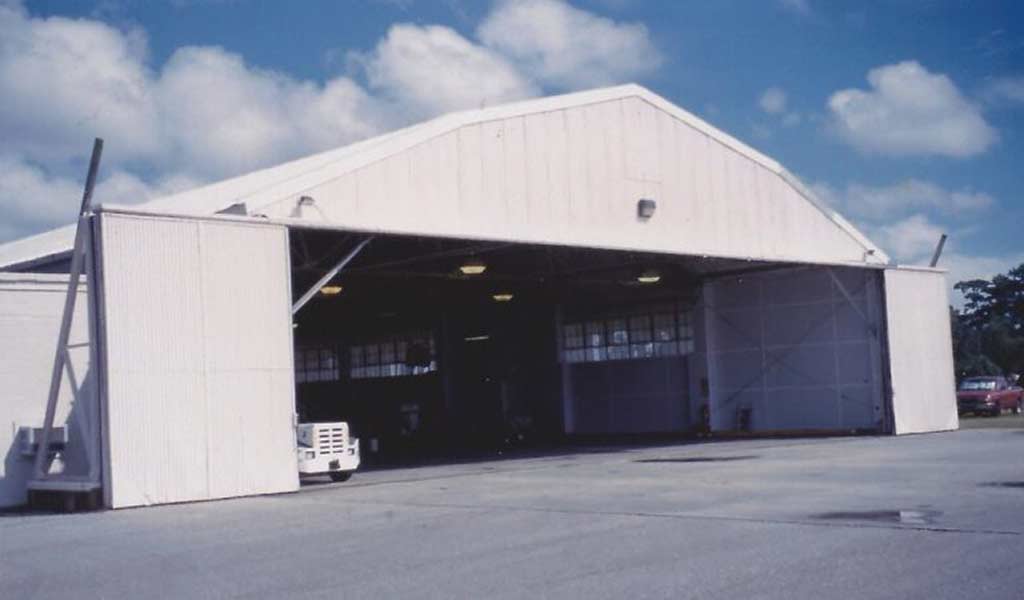The Haitian Hangar: MCAS New River’s Tie To The Banana Wars and One Hundred Years Of Marine Corps History

Although the history of Marine Corps Air Station (MCAS) New River dates to 1941, hangar AS-840, the “King Air Hangar,” so named because the station Headquarters and Headquarters Squadron maintains the assigned UC-12F and UC-12W “King Airs” there, can trace its history back to the Marine Corps’ early expeditionary years immediately after World War I, and back before the existence of the Fleet Marine Force (FMF), when the Corps was the spear point of American foreign policy in the Caribbean. The history of AS-840 is inexorably bound likewise to that of Marine Corps aviation and that of Camp Lejeune itself, along with its adjoining air station.
MCAS New River can claim a birth date along with the remainder of Camp Lejeune of 1
May 1941, the date LtCol W.P.T. Hill was directed by Major General Commandant Thomas Holcomb to establish a Marine barracks here to serve as a division training center. Included in that center would be an emergency landing field, New River’s progenitor. Even by that date, however, the hangar that would become AS-840 was already at least 20-years old and providing yeoman service for the Marine Corps airfield located at Parris Island.
The story of AS-840 begins in the western hemisphere’s second democracy, the island republic of Haiti, in 1915. For approximately three decades between the end of the Spanish American War and the beginning of the Good Neighbor Policy in the 1930s, the Marine Corps was the principal instrument used by the United States to implement and enforce its foreign policy in the Caribbean. In a series of interventions and occupations during that period known as the “Banana Wars,” American interests were protected and political stability maintained by Marine Corps expeditionary forces.
Violent political unrest in Haiti bordering on anarchy brought a landing party ashore at the Haitian capital of Port-au-Prince from the cruisier U.S.S. Washington on 28 July 1915, initiating the Corps’ longest occupation. The buildup of military force culminated with the arrival of the 1st Provisional Marine Brigade, consisting of the 1st and 2nd Regiments of Marines from the Advanced Base Force under the command of Col Littleton W.T. Waller on 15 August. Europe was aflame from World War I and Imperial Germany was known to harbor an interest in establishing a base for its High Seas fleet in Haiti. A German base astride a main Atlantic line of communication and threatening the canal in panama was strategically unconscionable.
Then as now, Marine expeditionary forces included a supporting aviation element, in this case, Squadron E Marine Aviation, with seven HS-2 seaplanes and six JN (“Jenny”) landplanes. Squadron E debarked at Port-au-Prince on 31 March 1919, the seaplanes initially operating from the Haitian Navy yard at Bizoton, with its marginal facilities, three miles east of the capitol. By November 1921 the facility at Port-au-Prince had been considerably enlarged, the runways lengthened and new hangars constructed. The squadron consolidated its assets there at the newly named Bowen Field. The preponderance of historical evidence suggests that hangar AS-840 was born in this 1921 construction.
Haiti fills an appropriately revered chapter in the Marine Corps’ proud history. Smedley Butler and Dan Daly were awarded their second Medals of Honor for heroic actions there. Alexander “Sunny Jim” Vandegrift, who brought the 1st Marine Division together at the Marine barracks that became Camp Lejeune and honed it into the lethal fighting force that conducted America’s first offensive at Guadalcanal, learned his trade there as a lieutenant. Roy Geiger, the only Marine ever to command an army and the namesake of the camp adjacent to MCAS New River, the home to the Marine Corps’ east coast School of Infantry, twice commended Squadron E in Haiti.
However diminutive and innocuous hangar AS-840 may now appear, its weathered girders and trusses sheltered a progressive collection of Marine war planes in Haiti that grew from the fragile JNs to De Havilland DH-4Bs and Boeing-built O2B-1s, and to the Vought O2U-1 and SU-2 and 3 “Corsairs.” Marine pilots and gunners were the only aviators of any service to experience combat duty between the two world wars. In Haiti and elsewhere, using these sturdy biplanes, they developed and refined the techniques of what became the appropriately heralded doctrine of close air support Exercising the tactics of air-to-ground strafing runs and bombing strikes became routine against Haitian guerillas, and vital practice for the more deadly contest to follow in 1941.
One of Geiger’s young lieutenants, Lawson H.M. Sanderson, in an effort to improve bombing accuracy, developed a new tactic called “dive bombing.” Given the physical limitations of the aircraft of the period, specifically his DH-4B, the new technique was actually “glide bombing,” but nonetheless, Sanderson can be credited with pioneering this ground support innovation for the Marine Corps, as well as the remainder of the world’s combat aviation. Sanderson frequently brought along another young lieutenant as an observer while honing his bombing skills who would obtain legendary status, Lewis B. “Chesty” Puller.
Succeeding years found the brigade of Marines an active participant in the peace and prosperity as well as a suppressant to the political unrest that characterized the American occupation. By the third decade of the 20th century both the international and domestic political situation dictated a withdrawal and under the guiding principles of President Franklin Roosevelt’s Good Neighbor Policy, the 1st Marine Brigade hauled down its colors in Port-au-Prince on 21 August 1934 and returned to the United States. Returning with the brigade was VO-9M, Marine Observation Squadron 9, which because of the advances in naval aviation over the preceding 23 years, had been redesignated the 4th Air Squadron (with Flights G and H in Haiti) in 1920 from Squadron E, thenVO-2M in 1922, VO-9M in 1930, and finally VMS-3 in 1937, which served, flying out of the Virgin Islands, as the only Marine air unit to operate east of the United States during WW II.
At least one of the metal hangars constructed at Bowen Field was transported to Parris Island, South Carolina, where it was reassembled at the previously abandoned Marine flying field. This is believed to be the subject “Haitian Hangar.” The field had been established in 1919 and initially was the home of Flight L of the 4th Air Squadron but was closed only two years later in an economic measure. In January of 1934 the Works Progress Administration began to upgrade the field for use by the newly formed FMF, one of the improvements being the revitalization of the hangar from Haiti, which was designated AS-705. The field became operational in March of 1935, was named Page Field in July 1935, and was commissioned a Marine Corps Air Station on 1 December 1941.
AS-705 served capably as an integral component of MCAS Parris Island during World War II and in addition to the more conventional ongoing air operations, mostly involving PBJ “Mitchell” bombers and F4U “Corsairs”-the distant successors to the O2U and SU “Corsairs” of Haiti-was witness to the formation of the Marine Corps’ barrage balloon and glider programs, both of which to varying degrees would be part of Camp Lejeune’s future history.
Following the war and the calamitous draw down of American military strength, especially that of the Marine Corps due to a hostile administration, MCAS Parris Island was disestablished in 1946 and like New River served in a much-reduced capacity only as an Outlying Field (OLF) to MCAS Cherry Point until the advent of the Korean War.
Korea brought a renewed appreciation of the Marine Corps’ unique capability as the world’s premier expeditionary force when its rapidly fielded units first held the Pusan Perimeter against the previously unstoppable North Korean Peoples’ Army then struck at its vulnerable rear at Inchon, initiating a rout of the Communist forces. With substantially enhanced funding, the Marine Corps was able to reactivate many of the facilities that had remained virtually dormant since the end of World War II. New River, which had been commissioned as a Marine Corps Auxiliary Air Facility in 1944, then disestablished in 1945, was reactivated as a Marine Corps Air Facility on 1 October 1951.
New River in 1951, however, had no more capability to support air operations or host Marine Corps aviation squadrons than it did at its disestablishment in 1945. A massive expansion program for New River was begun that resulted in the air station that now holds all the rotary wing and tilt-wing platforms of the II Marine Expeditionary Force, a total of 15 squadrons, and supports the combat air assault capabilities for all east coast Operating Forces. In 1942 the air station, then known as the airfield at Peterfield Point, or more locally as “Camp Lejeune’s Airport,” acquired a standard-type, wooden nose-hangar for its PBJs. The air station did not acquire another hangar until 1952, this became the first step in its expansion and subsequent acquisition of the storied Haitian Hangar.
The MCAS at Parris Island was too constrained by the physical limitations of its site to adapt to the requirements of jet operations and the Marine Corps turned its attention to the former Naval Station at Beaufort, ten miles to the north. Page Field was to pass into history but AS-705 still had a role to play. In 1952 the hangar was disassembled and move once more, this time to New River, where it was reassembled in the old air field area across the taxiway from the previous location of the 1942 nose hanger and designated AS-840. There it remains today, not only the oldest Marine Corps operational hangar, but the oldest structure aboard the air station and all of Camp Lejeune, under its common name as the “King Air Hangar” and reposes as a quiet veteran of 100 years of Marine Corps history.
REFERENCES
Interview with Eugene Alvarez, Ph.D. Dr. Alvarez is the recognized expert on the history of Parris Is. and it is to his extensive research that we owe the story of the Haitian connection to the hangar that became AS-840 at MCAS New River.
– Parris Is: The “Cradle of the Corps, A History of the USMC Recruit Depo, Parris Is.SC, 1562-1983. Washington: Hist. and Mus. Div., HQMC, n.d.
G.W. Carr and J.E. Greiner. Completion Report Covering the Design of Camp Lejeune… for the US Navy Bureau of Yards and Docks, Contract Noy4751 April 15, 1941-September 30, 1942. Durham and Baltimore: Carr and Greiner, 1943, 2 vols.
Paola E. Coletta, ed. US Navy and Marine Corps Bases, Domestic. Westport: Greenwood Press, 1985.
Col Robert D. Heinl, USMC (Ret) and Nancy Gordan Heinl. “The American Occupation of Haiti,” Part I. Marine Corps Gazette, Nov78.
LtCol Edward C. Johnson, USMC. Marine Corps Aviation: The Early Years 1912-1940.
Washington: Hist. and Mus. Div., HQMC,1977.
- Robert Moskin. The Marine Corps Story. Boston: Little, Brown and Co., 3 ed., rev., 1992.
Gordan L. Rottman. USMC WW II Order of Battle: Ground and Air Units in the Pacific War, 1939-1945. Westport: Greenwood Press, 2002.
M.I. Shettle, Jr. USMC Air Stations of WW II. Bowersville: Schaertel Pub. Co., 2001.
Technical Records Branch, Public Works Div. MCB Camp Lejeune.
– YD Drawing No. 162029, Seaplane Base Near Peterfield Point, 27 May 1942.
– YD Drawing No. 228334, Record Map, Quadrangle 118, 25 August 1942.
– Map. Existing Conditions, MCAS, Grid C#, 19 Sep 2001
Interview with Stephen R. Wise, Ph.D., Director of the MCRD Parris Is. Museum, who generously shared what information the museum held dealing with the tie between AS-840 and Haiti.
Posted on: December 3, 2021


